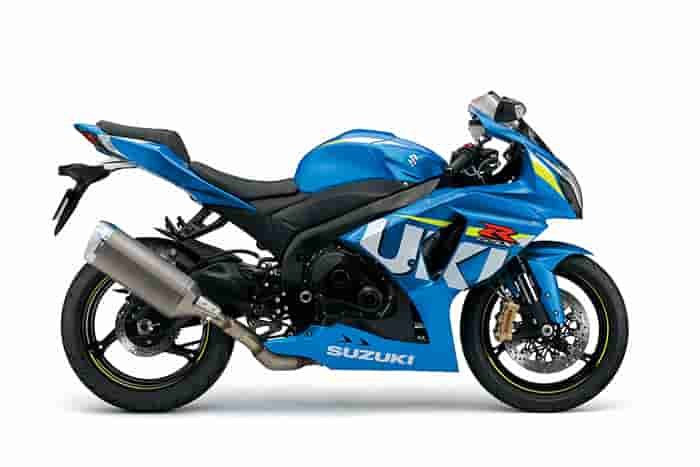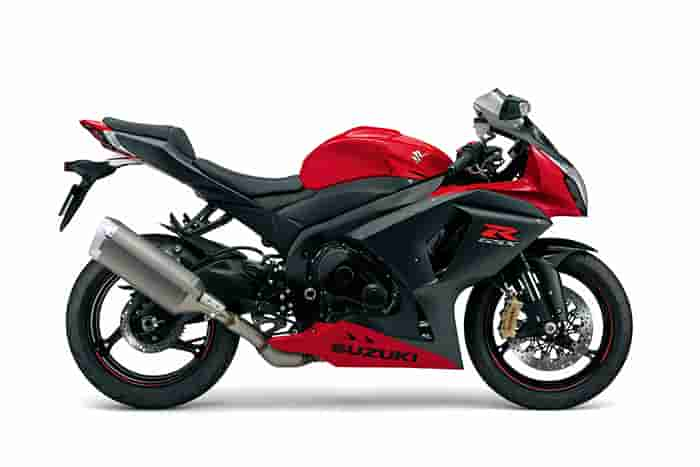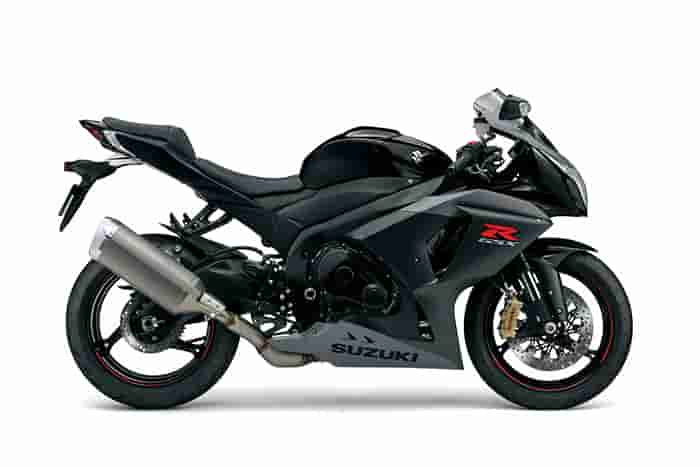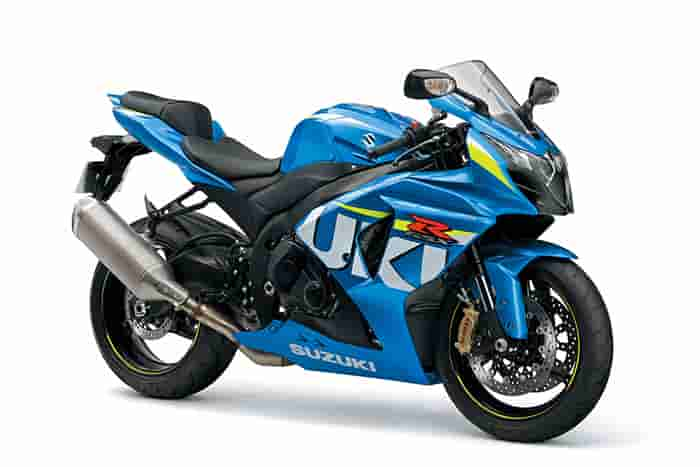The standard Multistrada 1200 features the
new Testastretta DVT engine with variable
valve timing, Bosch Inertial Measurement Unit, Bosch-Brembo ABS 9.1ME Cornering
braking system, cruise control, four Riding Modes, Ride-by-Wire Power Modes
(PM), Ducati Wheelie Control (DWC), Ducati Traction Control (DTC), a
height-adjustable seat, and an LCD dashboard. As you can see, the standard
version is quite far beyond standard.
The Multistrada 1200 S features those items, but with larger brake rotors,
Ducati Multimedia System (DMS), Sachs Electronic suspension with semi-active
Ducati Skyhook Suspension (DSS), full LED headlights with Ducati Cornering
Lights (DCL), and a full-color TFT dashboard. So, when you’re braking with the
ABS into a turn at night in the glow of TFT, the DSS adjusts as the LED is
complemented by the DCL, and when you twist the PM the DTC comes on before you
bang against the DWC, in your chosen PM, as the DVT is modulated by the IMU,
for a hearty LOL.
Get my point?
The biggest news is the Multistrada’s new Testastretta DVT engine’s
Desmodromic Variable Timing. This isn’t the first use of variable cam timing in
production motorcycles, but in its concept and range of ability the DVT system
goes leaps beyond other designs. What this means for the rider is, more
horsepower throughout the rev range, and 10 more horsepower at peak, for a
claimed 160 hp.
The DVT provides 45 degrees of variable timing for each cam, for a total of
90 degrees of synchronized variance (from +53 to -37 degrees of crankshaft
rotation). Like properly functioning EFI, you don’t notice its function; power
is just smoother, higher, and more efficient. The system adds a mere 5 kilos to
the bike’s weight, but that’s handily offset by the gains it provides.
The significance of variable cam timing is profiting from optimum intake and
exhaust valve overlap, which was historically a fixed value. Overlap is when
those valves are simultaneously open at the end of the upward exhaust stroke
and beginning of the downward intake stroke. With DVT, cam timing is
hydraulically varied by a single needle valve for each camshaft that controls
flow to housings on the belt-end of the camshafts. Hydraulic pressure causes
the pulleys and cams to vary their relationship based on what cam timing the
IMU requests.
Cam timing has always been a compromise between smooth running at low rpm
and good power at high rpm, with fuel efficiency also a factor. Now, for the
Multistrada, there is no compromise. Each cam positions itself in the
best-possible relationship to the crankshaft for all rpm. The elegance is possible
because Ducati’s Desmodromic valve operation needs much lower oil pressure to
drive the variable cam timing as it doesn’t have to fight the resistance of
valve springs.
While increasing power throughout the range, DVT improves mileage by a
claimed 8 percent. Dual sparkplugs per cylinder provide additional combustion
efficiency, working from separate ICUs and assisted by an anti-knock sensor.
Three different maps adjust power delivery. The 1198cc engine has a claimed
peak of 160 hp at 9,500 rpm, and 100.3 pound-feet of torque at 7,500 rpm. Drive
is through a wet slipper-type clutch.
The second biggest news for the 2015 Multistrada 1200 is the programable
rider-aid choices available at the push of a button. Each of the four versions
of Multistrada have four personalities for your riding pleasure: Sport,
Touring, Urban, and Enduro. Wait, is that four versions for each of the four
versions of Multistrada? Yes. So, in other words, you can have a Touring
Package bike that you choose to ride in Urban mode, and so forth.
Sport Riding Mode provides maximum power and torque, and sporty suspension
on the S model. Traction and wheelie control are at low levels, and the ABS is
at setting 2, maintaining Cornering ABS effectiveness.
Touring Riding Mode also features maximum power but with less-direct
throttle response. It has higher DTC and DWC sensitivity levels for enhanced
stability, and ABS is at level 3. On the S version, suspension is at maximum
comfort and DSS mapping is configured for carrying additional weight.
Urban Riding Mode power output is restricted to 100 hp, and on the S version
the suspension is set up for maximum agility, in concert with agile DSS
mapping. DTC and DWS are at high levels, and ABS is at level 3.
Enduro Riding Mode also restricts power to 100 hp, and the S uses off-road
suspension settings and DSS mapping. DTC and DWC are set low and ABS is at
level 1 for low-grip surfaces. Rear-wheel ABS detection is disabled, as is the
Cornering ABS.
The IMU (Internal Measurement Unit) is the soul of the Multistrada’s
four-bike concept in which the rider can choose from various levels of
“electronic strategies,” such as DWC, DTC, and Cornering ABS. The IMU measures
yaw, pitch and rate of change of each to permit maximum braking while
cornering, and it manages the DWC to inhibit the bike’s ability to wheelie. On
the 1200 S, the IMU controls the LED Ducati Cornering Lights. The DTC and DWC
each feature eight levels of sensitivity that can be reprogrammed from their
factory settings. The IMU additionally interacts with the semi-active Ducati
Skyhook Suspension (DSS) system of the S version.
The Brembo brakes of the Multistrada 1200 and 1200 S are matched to a Bosch
9.1ME ABS ECU. Cornering ABS utilizes the Bosch IMU to optimize braking front
and rear, even at serious lean angles. The Electronic Combined Braking System
is most active in Urban and Enduro modes, and least so in Sport. The rear-wheel
lift detection is fully employed in Urban and Touring but is disabled in Sport
and Enduro, and in Enduro the ABS is applied to the front wheel only. The
system has three levels. Sport utilizes level 2, for equilibrium between front
and rear, there’s no rear-wheel lift detection, and Cornering ABS is on.
Touring and Urban use level 3 rear-lift detection, while Enduro is set at Level
1. The standard Multistrada 1200 has Brembo radially mounted 4-piston calipers
and dual 320mm rotors in front, plus a 265mm single rotor. The S version has
330mm front rotors and Brembo M50 calipers mated to a 16mm master cylinder.
Both dashboards feature speed, rpm, gear, mileage, trip 1 and 2, engine
temperature, fuel level, time, riding mode, miles remaining, consumption rate,
average consumption, average speed, ambient temperature, traveling time,
freezing surface warning. And while the bike is not in motion, the menu allows
the rider to customize things such as DTC and DWC. Riding modes can be chosen
while parked or on the move, as is true of the suspension preload on the 1200 S
model. All Multistradas have an electronic key that engages with the motorcycle
if it’s within two meters. A conventional mechanical key on the electronic key
opens the fuel tank and releases the passenger seat. For security, there’s an
electric fork lock.
The frame is a refined trellis design with a rear subframe made of aluminum
castings. Rake is 24 degrees, trail is 4.3 inches. The single-sided swingarm is
a one-piece die-casting, with welded-in sections. The Pirelli Scorpion Trail II
tires are aggressively treaded for street and off-road riding. They’re sort of
off-road sporty touring tires with long life.
The suspension is manually fully adjustable for the 1200, and all
Multistradas have 6.7 inches of travel at each end. A narrower seat (compared
to the last Multistrada) provides an easier reach to the ground, and although
there’s 20mm of height-adjustability, the body is wider below the handlebar.
Also, the passenger seat is lower than on previous models, and the grab rails
have improved ergonomics. A reshaped windscreen allows one-handed
adjustability, and dry weight is a claimed 460 lb. (467 for the S).
The wheelbase is 60.2 inches with centered weight, and ergonomics allow
out-of-seat riding for off-road. The handlebar is tapered and rubber-mounted,
and there’s actual storage under the passenger seat, not just accidental gaps
between functional items. There are two optional 12-volt power outlets; one
under the dash, one under the passenger seat, and heated grips.
OKAY, SO WHAT’S IT LIKE TO RIDE?
The new Multistrada is tall, as are all bikes of this niche, but the narrow
seat does provide a reasonable reach to the ground. Getting beyond the multiple
choices of rider aids and customizable programming, the Multistrada performs
with agility. How could it not? The bikes we tested were flawless and smooth.
Riding them can increase your IQ by a good 12 points.
The difference between the Sport setting’s full power and the Urban’s 100 hp
is as noticeable as you’d expect: In Sport mode, in the higher revs, the bike
storms forward with a wonderful growl, and speed increases nice and fast. The
Sport Package includes Termignoni exhaust, which adds to the musical joy, but
all models have the intake howl.
In any mode the bike is equally smooth, which is testament to some seriously
complicated programming. If you so desire, you can shut off the DWC or DTC, but
you can’t turn them back on while moving, so plan ahead.
On the 1200 S, the suspension is soft when riding in straight line, for
maximum comfort, with Touring the best road-going choice. But as soon as you
get aggressive in corners, it goes all semi-active on you and the bike is well
planted. With the softness and long travel, speed bumps are something to
ignore. Well, as far as comfort goes.
All riding modes show a factory-set damping setting of “medium” when you
enter their menus. Since the suspension is semi-active, “medium” is just the
baseline for where damping starts. But, when questioned, an engineer pointed
out that each mode’s “medium” is a different “medium.” If you think about it,
you wouldn’t want an Enduro “medium” to be the same as a Sport “medium,” and so
forth.
Riding the 1200 Sport version makes it clear that it doesn’t have DSS.
That’s not a bad thing; it just reminds one of how manually adjusted suspension
that’s set at a sporty setting is at a sporty setting all of the time. You do
notice speed bumps.
The standard monotone dashboard has lots of small print on because of so
many functions. You must be under 40 or bring your reading glasses; the dash is
not available in a large-print version. The full-color TFT display of the 1200
S is grand.
Cruise control works well and is easy to set or reset. A really neat
feature: It can be disabled by twisting the throttle forward, beyond closed.
It’s intuitively perfect, mimicking what you’d do with an open throttle when
you desire to slow down.
Speaking about the throttle, it has a small bit of play. Unlike other
ride-by-wire systems, there are no cables, and the throttle housing has the
rheostat right within it, so, like the volume control on your stereo, there
should be no play. Unless someone purposely put it there…? An inquiry revealed
that, yes, it’s there for the purpose of letting the rider comfortably feel and
know when the throttle’s closed, and also to ensure that there’s a smooth
transition to opening it. These Ducati dudes aren’t stupid, that’s for sure.
In all, the handling is neutral, the braking is smooth, powerful and
consistent, and the feedback is nails on. Also, the Multistrada has a power
curve that only DVT can provide.
Prices for the 2015 Ducati Multistrada (in red unless otherwise noted):1200,
$17,695; 1200 Touring Package, $19,094; 1200 S, $19,695; (white) $19,895; 1200
S Touring Package, $21,094; (white) $21,294. The Packages purchased as options:
Sport Pack (Termignoni exhaust, carbon-fiber front fender, billet aluminum
brake and clutch reservoir caps), $1,399; Touring Pack (heated grips, hard
bags, centerstand), $1,399; Urban Pack (top case, tank bag, USB hub), $899;
Enduro Pack (driving lights, Touratech crash bars, radiator guard, skid plate,
enlarged side-stand base, off-road footpegs), $1,399.



















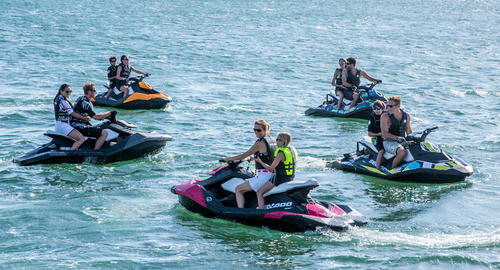 Sea-Doo's groundbreaking Spark returns for 2015 in an assortment of eye-catching colors.
Sea-Doo's groundbreaking Spark returns for 2015 in an assortment of eye-catching colors.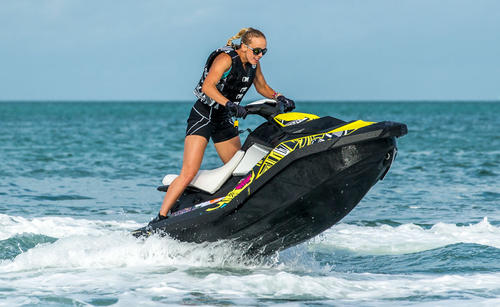 Thanks to its light weight, the Spark's relatively small engine has no trouble providing a fun ride.
Thanks to its light weight, the Spark's relatively small engine has no trouble providing a fun ride.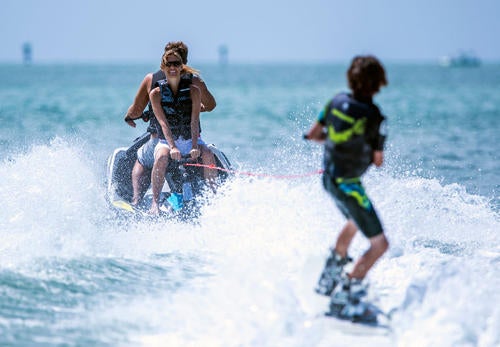 While it can't provide the same quality ride as other Sea-Doo craft, the Spark has enough juice for basic towing duties.
While it can't provide the same quality ride as other Sea-Doo craft, the Spark has enough juice for basic towing duties. Though it may not be able to carve as tight a corner as some models, the Spark is capable of spirited handling.
Though it may not be able to carve as tight a corner as some models, the Spark is capable of spirited handling.
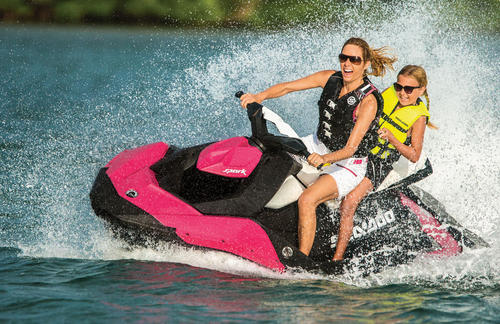 With a base price of just $4,999, the 2015 Sea-Doo Spark is available with a host of price-bumping options.
With a base price of just $4,999, the 2015 Sea-Doo Spark is available with a host of price-bumping options.

.jpg)










